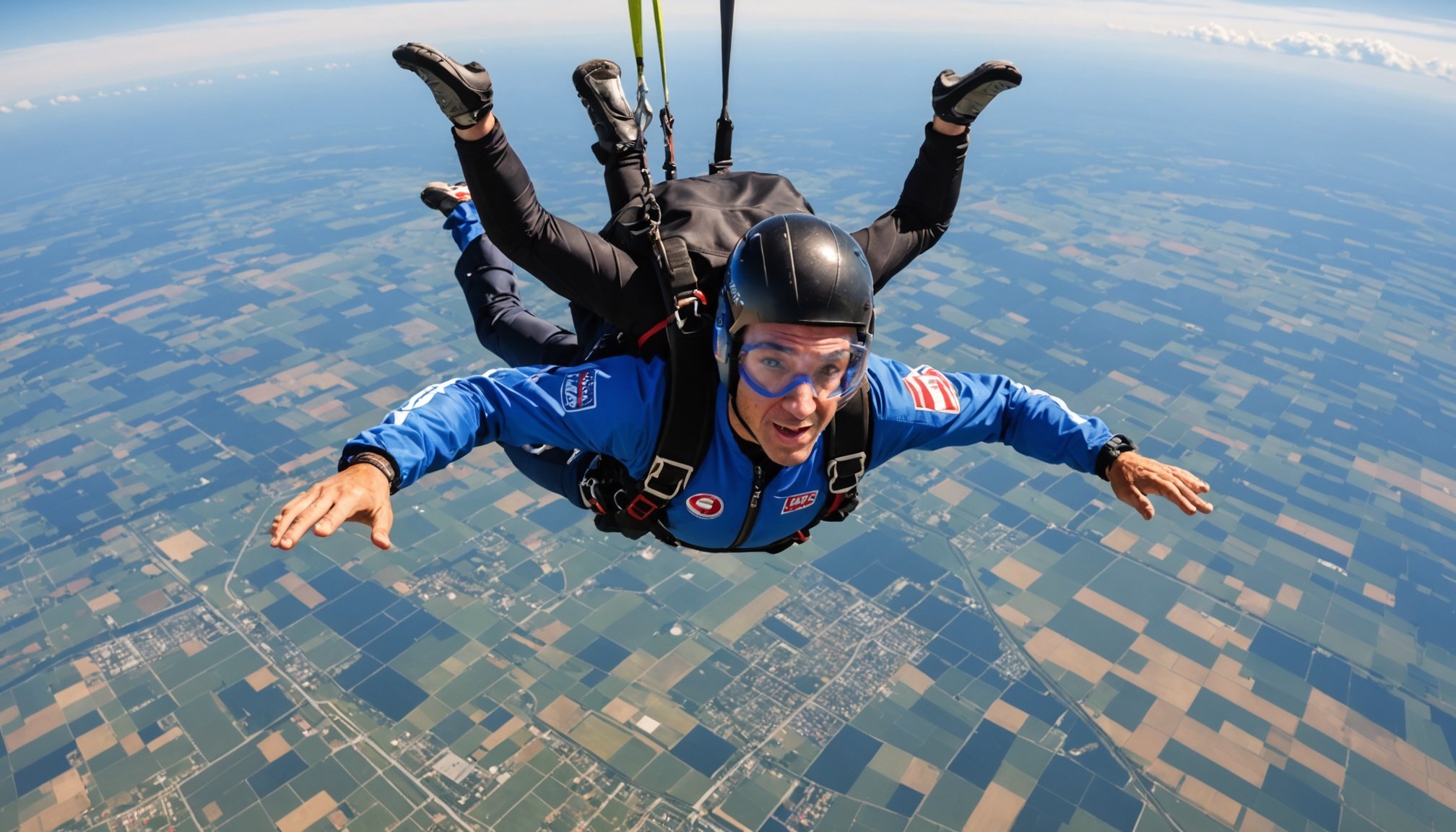Understanding Barometric Pressure and Its Importance in Skydiving
Barometric pressure is the measure of the force exerted by the atmosphere above us. It plays a crucial role in weather patterns and influences activities like skydiving. In skydiving, knowing the precise barometric pressure is essential for safety and performance.
As altitude increases, barometric pressure decreases. This relationship is vital for skydivers because it affects the altitude measurements that are critical for determining the right time to deploy the parachute. Accurate pressure readings ensure a precise calculation of altitude, which is pivotal for a safe jump.
Also to read : Mastering endurance: essential strategies for rowers to dominate long-distance competitions
Skydiver’s altimeters rely on barometric pressure to provide real-time altitude data. These tools must be accurately calibrated to avoid miscalculations that could lead to accidents. Without reliable data, skydivers risk deploying their parachutes either too early or too late, jeopardizing their descent and landing.
Atmospheric pressure impacts every phase of a skydive, from freefall dynamics to the opening of the parachute. Thus, understanding its role and ensuring accurate readings is fundamental to improving skydiving safety and performance. Accurate pressure and altitude data are a skydiver’s best allies in making informed, timely decisions during a jump.
This might interest you : Unleash Your Potential: Expert Nutrition Strategies for Wrestlers to Achieve Ideal Weight and Muscle Growth
Aerodynamics of Skydiving
Understanding the basics of aerodynamics is crucial for skydivers, impacting everything from freefall dynamics to landing precision. During freefall, the interaction between a skydiver’s body and air results in a drag force that opposes gravity. The shape, position, and orientation of the body significantly alter this force.
Different body positions, like the stable belly-to-earth position, create varying levels of drag. More streamlined positions, such as diving headfirst, reduce drag and increase freefall speed. Conversely, spread-eagle positions maximise drag, slowing the descent.
Changes in barometric pressure also influence these dynamics. As pressure decreases with height, the density of air changes, affecting drag. This requires skydivers to adjust their body positions for optimal performance and control. For example, lower atmospheric pressure at higher altitudes results in less air resistance, altering how quickly a skydiver reaches terminal velocity.
Understanding the relationship between body positioning, drag, and air pressure allows skydivers to fine-tune their jumps. Mastering these aerodynamic principles ensures freefall stability, safety, and an exhilarating descent, making each skydive an adventure in precision and skill.
Altitude Calculations in Skydiving
Precisely calculating altitude is crucial in skydiving safety, as it informs the timing for parachute deployment. Skydivers rely on altitude instruments that measure pressure altitude, using adjustments in barometric pressure to determine height above sea level. This method is essential for ensuring jumps are executed safely.
Accurate altitude measurements are paramount not only for landing safely but also for optimising the freefall phase and avoiding collisions. Pressure altitude is a critical concept because traditional GPS devices, which calculate geometric altitude, do not account for atmospheric variations. This distinction highlights the significance of barometric-based measurements for skydivers, as they provide data adjusted for air pressure changes.
Advancements in technology have introduced sophisticated tools, such as digital altimeters and audible alerts, which enhance accuracy and alert skydivers in real-time. This technology significantly reduces human error in altitude calculations and enhances safety measures.
Ultimately, understanding the methods and tools for calculating altitude empowers skydivers to make timely, informed decisions during their jumps. Being knowledgeable about these calculations ensures that skydiving remains a thrilling, yet controlled and secure, extreme sport.
Safety Considerations Relating to Barometric Pressure
When skydiving, understanding the effects of barometric pressure is pivotal to safety. Rapid changes in atmospheric conditions can lead to dangerous situations if not properly managed. Barometric pressure effects influence altitude readings. Thus, skydivers must remain vigilant for potential hazards during their descent.
Emergency procedures are crucial when facing sudden pressure changes. For instance, if a significant drop in pressure occurs, skydivers must have predefined protocols to adjust their descent quickly. Knowing how to respond can prevent mid-air collisions and ensure a safe parachute deployment.
Training and preparation are indispensable for managing variations in pressure. Skydivers undergo rigorous training to recognize and react to pressure-induced anomalies. Simulations and drills help them gain confidence in handling unpredictable atmospheric conditions. This approach minimizes risks related to incorrect altitude readings and pressure changes.
Equality important, clear communication with ground control is vital for updating environmental conditions. This enables skydivers to make informed adjustments in real-time. By focusing on preparation and employing appropriate emergency procedures, skydivers can maintain safety, even when barometric pressure fluctuates unexpectedly during a jump.
Comparative Analysis of Pressure Effects at Different Altitudes
Atmospheric pressure effects vary markedly between low and high altitudes, influencing the skydiving experience. At low altitudes, higher atmospheric pressure provides denser air, increasing drag during freefall. This condition allows more precise control and a steadier descent, making it conducive for beginners or tandem jumps.
Conversely, high altitudes bring decreased atmospheric pressure and less air resistance. This scenario increases freefall speed and can lead to rapid descents, requiring adjusted technique and careful monitoring of altitude calculations. Skydivers at these altitudes often employ advanced aerodynamic positions to optimize stability and control.
The variance in pressure effects significantly alters the freefall experience. For instance, descents from high altitudes necessitate wearing supplemental oxygen due to reduced oxygen availability. Moreover, specialized training is crucial to handle the shift in dynamics effectively, which can include alterations in emergency protocols.
Real-life skydiving examples illustrate these atmospheric variations. Notably, record-setting high-altitude jumps have demonstrated the challenges and exhilaration of low-pressure environments, highlighting the necessity for accurate instrumentation and robust preparatory measures to ensure safety and performance excellence across varying conditions.
Impact of Barometric Pressure Changes on Freefall Dynamics
The freefall dynamics of skydiving are intricately linked to pressure changes encountered during a jump. These dynamics determine how quickly a skydiver descends and the stability maintained during freefall. A key factor influencing freefall speed is the barometric pressure, which varies with altitude. When pressure decreases at higher altitudes, air density lowers, affecting a skydiver’s fall rate and posture adjustments need to be made to maintain control.
Sudden pressure changes can challenge stability, demanding a modification in techniques to counteract any undesired motion. For instance, when atmospheric pressure declines sharply, skydivers might find themselves increasing drag through wider body positions to counter the lack of air resistance. This ensures a stable and controlled descent, which is crucial for effective parachute deployment.
Significant incidents demonstrate the importance of understanding these variations. For example, during prolonged jumps from higher strata, skydivers have faced unexpected swirls due to abrupt atmospheric anomalies. By adapting their freefall techniques in light of pressure adjustments, skydivers can enhance safety and performance. These adaptations underline the importance of recognising and preparing for the ever-changing atmospheric pressure conditions experienced during skydives.











